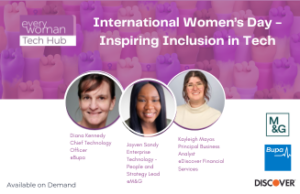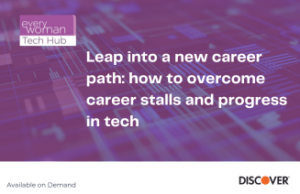The tech industry is booming; in 2018, UK tech firms attracted more funding than any other European country. But while advancements such as AI and virtual reality may be providing exciting disruption, how well is the tech industry itself challenging its own white, male-dominated status quo to become more diverse?
Organisations that encourage inclusive cultures are known to thrive, as well as inspiring and nurturing innovative technologies that benefit both the company and wider society. However, the industry continues to remain markedly imbalanced – only 17% of IT specialists in the UK are female and the number of women in the sector has barely moved over the past decade.1 At the 2020 everywoman in Tech Forum, our research partner WhartonBC surveyed over 230 representatives from across the technology sector, including 35 STEM graduates, exploring critical topics around speaking up, inclusion and innovation.
Here, we reveal five key insight areas from this research — and consider what women in tech can do now to help move the needle on gender imbalance.
1. Accountability and congruence are key
Within the Tech sector, 89% of businesses struggle to recruit, and with 6.1 million jobs expected to be created in the sector globally up to 2022 ‘we simply do not have enough people in the tech workforce to meet demand’, noted Lisa Sherwell, VP of SUSE, a speaker at the 2020 everywoman in Tech Forum. Broadening the talent pipeline and demonstrating true inclusion therefore will be key to ensuring the UK sector can stay competitive on the global stage as tech expands.
The challenge: A lack of D&I activity was cited as the number one reason for delays in real gains toward creating a balanced technology industry. Our research shows that 60% of tech women feel there is a mismatch between what is said and what is done around diversity in companies; STEM Graduates are even more cynical — with 91% feeling there is a mismatch. D&I is often still an afterthought for many companies, but to challenge the status quo it cannot be a rarefied initiative or background HR activity — actions need to be inclusive and D&I marbled through the company culture. In addition, accountability is key: defining and measuring progress goes hand-in-hand with vision to create meaningful change.
Moving the needle: Making D&I ‘mainstream’ in business practices starts with overthrowing the idea of ‘special interest groups’ or isolated D&I change programmes in favour of setting up core ways of working that can include the whole workplace — ultimately positioning D&I as fundamental to the business culture itself. That means rethinking the objectives you set for your teams, job profiles and even what defines success, as well as building D&I into frameworks so that diversity of thought is recognised as central to being risk aware. Focus on role modelling the desired behaviours and encourage everyone at all levels to challenge those who don’t adhere to the expected behaviours. Recognising and rewarding not only what people do but also how they do it will also help to embed values into everyday action.
2. Inclusive cultures encourage diverse voices.
WhartonBC’s research partner John Higgins2 found that speaking up and being heard is more of a challenge for females than males across a range of industries; female voices often go unheard, with males less likely to value the views of others. In such a male-dominated industry as tech this is amplified: indeed, more than half of our respondents reported that getting women to speak up is treated as a ‘women’s issue’ — and yet women’s voices are crucial to drive initiatives, raise issues, shape product and create visibility for the female workforce.
The challenge: Differences in how people experience their own power and the power of others lies at the heart of the choices people make about whether they are going to speak-up or stay silent — with important connotations for those who are working to create inclusive cultures. Attempts to address diversity in the workplace still usually avoid considering hierarchical power dynamics, and instead follow an assumption that creating systems and structure to facilitate the raising of issues will be enough to level the field.
Moving the needle: Acknowledge the impact of power and hierarchy on the ability of people to ‘speak up’, and critically evaluate your internal business culture on this basis. The answer, though, is not just about facilitating people to speak up, but in then listening to what they have to say and building a culture in which their opinion, thoughts and ideas are shown to matter. American financial services company State Street3, for example, developed its people to ‘listen up’ not just ‘speak up’ and found that focusing on enabling leaders to ‘listen better’ built trust rapidly and gave junior employees the space to be more vocal.
3. Innovation requires failure
Innovative business cultures require leaders who can role model empathy, recognise failure as a learning opportunity and actively seek out and listen to alternative views and perspectives. Our research finds that 47% of tech women believe that leaders in their organisation focus on changing the technology but not the skills and capabilities needed to make use of these.
The challenge: 61% of tech women feel that people in their organisations are not willing to be public about failure, showing that the culture of perfectionism and under-confidence remains powerful. Without the public sharing of mistakes and disappointments, learning is superficial and innovation stifled; and without a culture in which it is accepted and even encouraged to ‘fail up to success’ employee engagement, inclusion and creativity is fundamentally undermined.
Moving the needle: Creating a ‘fail safe; fail fast’ environment is crucial to inclusive and innovative business cultures, allowing people to take risks, think differently and innovate. Help your organisation to increase its transparency at all levels by openly sharing successes, failures and pain points with your team, as well as encouraging this overtly in others. Making a change here can be anything from a personal discussion to an ambitious policy shift. For example, Sam Yagan, ShopRunner CEO, asked executives in their reviews to describe recent failures. If the failures hadn’t cost the company money, the executives didn’t get their bonuses.4
4. Flexibility encourages the talent pipeline
Those coming into the industry do so with a markedly different outlook on the role and reasoning for work that any generation before them — purpose, value and flexibility are key drivers and the ability and willingness to transform and challenge outdated cultures will increasingly determine how attractive companies are to a younger, more diverse talent pipeline.
The challenge: Many nascent in the industry are sceptical about the willingness of organisations to embrace flexible working, as well as display the kind of emotional intelligence that fosters transformation and allows them to ‘make a difference’ — 91% of STEM graduates are concerned that asking to work flexibility will reflect badly upon them. Furthermore, 41% of tech women say that their senior leaders do not make a genuine effort to listen to junior employees. Remaining unchallenged about how the business should progress is something that they cannot afford to do — especially given that Millennials make up half the workforce.5
Moving the needle: Our survey equally rated empathy and listening as skills that need strengthening across the tech sector, and it’s clear that leaders with emotional intelligence are vital to bridging and encouraging the next generation. Working on your own EQ is both professional development and an investment in the sector — everywoman has a number of great resources to set you off on the right track including workbooks and webinars. Championing all variations of flexible working can also help to lower barriers, create the broadest possible talent pool and engender inclusion, growth and trust among employees.
5. Challenging unconscious bias is an ongoing commitment
Unconscious bias continues to influence ways of working and undermine truly diverse and inclusive business culture. Our research finds that 67% of tech women feel that their senior leaders are unaware of their own unconscious biases. In addition, many speakers at the everywoman in Tech Forum referred to the risk that bias is ‘accidently’ built into technology through AI and design flaws, underlining the need to speed up gender representation parity in tech at both leadership and product development levels.
The challenge: Our data suggests that what gets heard and not heard within the tech sector co-exists with other biases, impacting attention and limiting the ability for innovation. AI and data bias as well as ‘advantage blindness’ also impact strongly – the latter limiting the ability of those in positions of power to see what is being experienced by others and take on the significant insights afforded by diversity of thought.6 While it’s impossible to erase unconscious bias, organisations can tackle underlying behaviours and redesign processes to uncover these and reduce their impact, Ultimately, the tech sector needs to overtly commit to active management of the risks of unconscious bias if the solutions it creates are not to accidently reinforce historical stereotypes.
Moving the needle: As Melanie Eusabe7 argues, actively encouraging the capability of managers to apply a growth mindset, so that individuals look beyond assumptions and stereotypes is a powerful approach to starting to dismantle bias. Implement changes that challenge the framing effect of unconscious biases practically, from recruiting with ‘name blind’ CVs to reworking job descriptions so you’re able to draw from a wider pool of applicants and encouraging open dialogue in your teams. The more people involved in a decision — and the more transparent the decision-making process — the less likely it will be to be affected by unconscious biases. Importantly, continue challenging your own actions and unconscious bias — getting feedback from colleagues and using tools such as Harvard’s Implicit Association Test.8 In holding yourself to account in this way, you model powerful progressive behaviour and grow as a leader — in turn challenging others to grow too.
———————–
1 Ten years on, why are there still so few women in Technology, Guardian Article Jan 2020
2 ‘Speaking Truth to Power at Work’, Reitz, M, Nilson, V, Day E and Higgins J, 2019 Hult Research
3 K. Newell (2019), Transforming Financial Sector Culture, Panel discussion, City Week 201
5 PWC (2011). Millennials at Work; Reshaping the Workforce
6 Do you have Advantage Blindness’, Fuchs, Reitz and Higgins 2018, HBR
7 M.Eusabe (2019) The Art of the Possible; Defying stereotypes & Preconceptions through Inclusion, Everywoman in Risk Forum 2019



